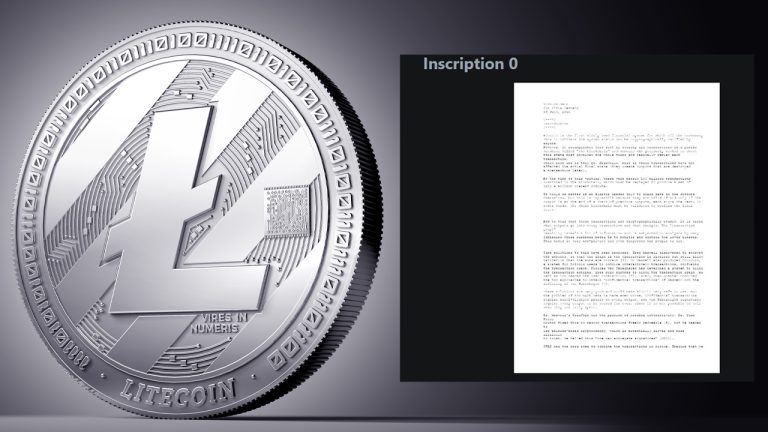 After the Kucoin indictment on Tuesday, subsequent onchain data from Nansen indicates that, to date, $1.7 billion in funds have been withdrawn from the exchange. Crypto Assets Worth $1.7 Billion Pulled From Kucoin Since the Department of Justice (DOJ) accused Kucoin and its founders of breaching the Bank Secrecy Act and anti-money laundering regulations, there […]
After the Kucoin indictment on Tuesday, subsequent onchain data from Nansen indicates that, to date, $1.7 billion in funds have been withdrawn from the exchange. Crypto Assets Worth $1.7 Billion Pulled From Kucoin Since the Department of Justice (DOJ) accused Kucoin and its founders of breaching the Bank Secrecy Act and anti-money laundering regulations, there […]
Three key Bitcoin price indicators explain why BTC price continues to fall toward new lows.
Bitcoin (BTC) surpassed the $30,000 resistance on June 21, or 40 days ago, after a notable 19.5% gain in a week. Since then, it has been moving within a range filled with occasional moderate corrections and BTC price trades near $29,300. While these consolidation periods are common in traditional markets, they tend to make crypto investors quite anxious.
As Bitcoin's price repeatedly fails to break the $31,000 level, traders are becoming increasingly tense and their sentiment is worsening. This trend could reverse suddenly, regardless of any relevant news or macroeconomic factors that might support an upward move andcrypto traders' emotions can magnify positive and negative price swings, leading to euphoric and fear-led price action.
The increased anxiety among traders is partly due to Bitcoin's historical volatility, which used to be much higher than its current levels. Presently, the 33% annualized 50-day volatility is the lowest in 6 months, contrasting sharply with the 60% or higher volatility observed for 245 days throughout 2022. Despite the rationale for this shift, the recent period has been relatively calm for Bitcoin's price.
To put it in perspective, consider that auto and electric battery producer Tesla (TSLA), a top-10 global asset and part of the S&P 500 index, currently experiences a 58% annualized volatility. In comparison, graphics chipmaker NVidia (NVDA) has consistently demonstrated a 70% or higher volatility for most of 2021.
While some analysts use volatility data to predict trends, it's essential to note that this indicator relies on absolute price changes, yielding the same outcome for both upward and downward price swings. Therefore, volatility only provides information about the magnitude of daily oscillations.
However, apart from price changes, there are other metrics that can indicate investors' excitement or lack of interest in an asset, such as evaluating its market share or market dominance.
On July 30, Bitcoin's market share in the total crypto capitalization dropped to 49.5%, the lowest figure since June 16.

This decline can be partially attributed to a favorable legal decision for Ripple Labs on July 13, which reduced regulatory risks for altcoins. Industry representatives believe this decision will benefit crypto exchanges Coinbase and Binance in their SEC lawsuits. The diminishing dominance of Bitcoin marks a trend shift from the gains observed between December 2022 and June 2023 when it increased from 40.2% to 52%.
Bitcoin's 1-year active supply, representing the sum of unique BTC transacted in the trailing 12 months, reached its lowest level since February 2016 at 6.0 million BTC as of July 26. This data, compared to the 6.2 million BTC activity three months prior, raises concerns, especially with the potential approval of spot ETFs in the U.S.

The decreasing number of Bitcoin moved on-chain might have been offset by the increased use of the Lightning Network as an alternative solution. However, this Layer 2 solution currently holds a mere $138 million in Total Value Locked (TVL) and shows a near unmoving 16,382 nodes in the past 30 days.
Related: US banking advocacy group supports Sen. Warren’s reintroduced crypto bill
The main "fear and greed" metric for Bitcoin options, the 25% delta skew, indicates that bulls are becoming less confident over time. Readings above 7% suggest traders anticipate a drop in Bitcoin's price, while periods of excitement typically yield a -7% skew.

Currently, the 30-day metric remains flat at 1%, indicating a balanced demand between call (buy) options and protective puts, signaling a neutral market. However, it does show a decreased appetite among bulls compared to the 2% to 14% discount on neutral-to-bearish put (sell) options between June 19 and July 29. This derivatives data strongly supports the notion that traders have become less confident since the $29,500 support level broke.
As investors' mood worsens and indicators point to increased tension, Bitcoin price faces mounting pressure in the near term. Falling dominance, lackluster network activity and concerns in the options markets all contribute to the potential negative impact on Bitcoin price. On a positive note, if traders remain cautious and anticipate further downward movement, the likelihood of excessive liquidations among leverage traders is reduced.
This article is for general information purposes and is not intended to be and should not be taken as legal or investment advice. The views, thoughts, and opinions expressed here are the author’s alone and do not necessarily reflect or represent the views and opinions of Cointelegraph.

BTC price soared on investors’ ETF hopes, but on-chain and derivatives metrics indicate a limited inflow of new investors
The price of Bitcoin (BTC) has been trading between $29,900 and $31,160 for the past 18 days, causing concern among investors who are looking for explanations for the lack of a clear trend.
After a 25.5% rally between June 15 and June 23 leading to Bitcoin’s highest level in 13 months one would expect investors to become more active and optimistic, but the lack of BTC’s ability to sustain prices above $31,000 and neutral on-chain and derivatives data do not corroborate this thesis.
The current price situation is particularly worrisome because of the expectations that arose after BlackRock, the world's largest fund manager, applied for a spot Bitcoin ETF on June 16. Some analysts have predicted a Bitcoin price of $100,000 by the end of the year, adding to the frustration of traders who are betting on further gains.
It's worth noting that in mid-April, investors experienced a consolidation of prices around $30,000, but it didn't last longer than a week, and the price eventually dropped to $28,000. This movement explains why investors are hesitant to build positions at the current price levels and prefer range trading.
Despite the initial excitement about the possibility of the U.S. Securities and Exchange Commission (SEC) approving a Bitcoin instrument for traditional finance markets, there's negative price pressure due to the regulatory actions against leading exchanges like Coinbase and Binance.
This combination of positive triggers and a stricter regulatory environment is likely the main cause of Bitcoin's recent price movement, and analyzing blockchain data could provide insights into the network's use.
When it comes to blockchain-based analysis, network activity should be the starting point. This analysis should entail looking beyond just trading and exchange flows. Cryptocurrencies were designed to facilitate free transactions and the registration of digital assets, so the number of active users is crucial.

Bitcoin's 7-day active addresses have failed to exceed 1 million, only reaching the same levels as three months ago. Moreover, the peak of 1.02 million addresses in April 2023 was 16% lower than the all-time high in January 2021. Therefore, on-chain data indicates a stagnation in the number of active users on the Bitcoin network, using addresses as a proxy.
One might argue that reclaiming the level of active addresses back in April 2023 is good enough, but to evaluate the demand from institutional investors one should analyze the network's address count with a minimum of 100 Bitcoin, which is worth over $3 million at current price levels.

Upon closer examination, it becomes evident that the indicator has remained unchanged for the past few months in 15,900 addresses. This suggests that there hasn't been an increase in the number of whales accumulating Bitcoin during that period.
Considering this, along with the fact that active addresses haven't reached new highs, on-chain metrics suggest that the ETF launch hasn't yet triggered a bullish momentum.
To confirm whether the price reflects stagnant network activity, one should analyze Bitcoin derivatives metrics and measure the demand for leverage from professional traders. In neutral markets, Bitcoin quarterly futures contracts typically trade at a 5 to 10% annualized premium, known as contango, which is not unique to crypto markets.

The Bitcoin futures premium crossed the neutral 5% threshold on June 26, just five days after the $30,000 support level was breached. It took investors a full 18 months to turn bullish using leveraged long positions, reaching the highest price point since June 2022. This significantly increases the likelihood of liquidations and panic selling if the Bitcoin price drops by 8% in a short period.
Looking at the options markets is also helpful, as the 25% delta skew is a telling sign of when arbitrage desks and market makers overcharge for upside or downside protection. In essence, if traders anticipate a Bitcoin price drop, the skew metric will rise above 7%, and phases of excitement tend to have a negative 7% skew.

However, the 25% delta skew failed to sustain levels below the neutral threshold for more than four days. The only period of moderate bullishness, according to the options pricing indicator, was from July 1 to July 5. The current balanced demand between call and protective put options indicates a lack of confidence from professional traders.
These findings are particularly disappointing considering that senior Bloomberg analysts estimated a 50% chance of Bitcoin ETF approval. After the recent price rally above $30,000, one would expect on-chain and derivatives data to reflect more optimism, which might be influenced by Bitcoin's price being 56% below its all-time high, or the impending court rulings against the exchanges.
Ultimately, at the moment, on-chain and derivatives data fail to support the bullish momentum to sustain further price gains.
This article is for general information purposes and is not intended to be and should not be taken as legal or investment advice. The views, thoughts, and opinions expressed here are the author’s alone and do not necessarily reflect or represent the views and opinions of Cointelegraph.
 On May 15, 2023, the number of Ordinal inscriptions surpassed the 7 million mark and as of 9:00 a.m. Eastern Time on Tuesday morning, 7,204,882 Ordinal inscriptions have been added to the Bitcoin blockchain. Miners have collected 1,324 bitcoin in fees by confirming inscription transactions which equate to roughly $35.86 million in added onchain fees. […]
On May 15, 2023, the number of Ordinal inscriptions surpassed the 7 million mark and as of 9:00 a.m. Eastern Time on Tuesday morning, 7,204,882 Ordinal inscriptions have been added to the Bitcoin blockchain. Miners have collected 1,324 bitcoin in fees by confirming inscription transactions which equate to roughly $35.86 million in added onchain fees. […]
"We urge @CamelotDEX delete any information related to @OnchainTrade from all of your platforms as soon as possible," wrote OnChain developers.
In a dispute that originated Feb. 22, decentralized exchanges (DEXs) Onchain Trade and Camelot terminated an agreement for the former's initial fair offering (IFO), with both firms alleging that the opposing counterparty acted in bad faith. An IFO, whilst still an emerging concept, typically involves promises made by developers consisting of no venture capitalist involvement, no whitelist, no presale, and vast majority of income going to token holders, on top of a traditional initial coin offering.
As told by Onchain, developers began negotiations with Camelot for an IFO, for which the latter charged a fee of 2%, and both parties agreed upon the amount. In addition, Camelot required that Onchain exclusively sell tokens on its platform, to which Onchain also agreed. However, at this point, Onchain alleged that Camelot became "more demanding and trying to start another round of bargain; we started feeling uncomfortable working with Camelot and decided to terminate deal with them altogether."
In a follow-up Chinese language tweet, Onchain, which stated its core developers "come from China," explained that the root cause of the disagreement was the "no-limit" token sale allegedly demanded by Camelot. "There are many opportunities in the bear market; retail investors simply don't have the risk management and valuation capabilities to assess projects," Onchain developers wrote.
In response, Camelot said that Onchain's statements were "false allegations." According to Camelot's version of the story, its IFO sales model "was never mentioned as being an issue from their team [OnChain]."
"This low number [2% fee] which never once changed from our side, was set well below market for such a launch due to a desire to support the ecosystem and facilitate a protocol transitioning over from zksync."
Regarding exclusivity, Camelot explained that "doing a multiple IDO [IFO] model isn't feasible, and the same was clearly communicated, and on multiple occasions the OCT team confirmed understanding." The firm then accused OnChain's leadership of "acting in bad faith or simply being inexperienced" and "denials after the fact" in a series of direct messages, which Camelot said led to their cancellation of the deal.
We’ll work hard to try and make every project succeed, but some will and some won’t. But in the end, those that fail to understand your words matter, will never have a seat on the Round table.
To which Onchain replied: "tricking us into canceling deal with other partners and starts bargaining round over round thinking we can't live without you, calling that good faith." Onchain has since decided to move its IFO directly onto its website. At the time of publication, Cointelegraph was not able to independently confirm the allegations presented by either party.
"Onchain Trade team is so inexperienced in grifting that they cancelled a chance to grift hand in hand". Tricking us into cancelling deal with other partners and starts bargining round over round thinking we can't live without you, calling that good faith. https://t.co/ibKLctNdht
— OT | Onchain Trade (@OnchainTrade) February 23, 2023
 According to statistics recorded this week on Tuesday and Wednesday, the layer two scaling project Arbitrum’s transaction count has surpassed Ethereum’s. On Wednesday, Arbitrum processed 1,090,510 transactions, compared to Ethereum’s 1,080,839 transfer count. L2 Scaling Solution Arbitrum’s Daily Transfers Skyrocket Layer two (L2) scaling networks have become popular over the last two years as secondary […]
According to statistics recorded this week on Tuesday and Wednesday, the layer two scaling project Arbitrum’s transaction count has surpassed Ethereum’s. On Wednesday, Arbitrum processed 1,090,510 transactions, compared to Ethereum’s 1,080,839 transfer count. L2 Scaling Solution Arbitrum’s Daily Transfers Skyrocket Layer two (L2) scaling networks have become popular over the last two years as secondary […] Following a growing trend of Ordinal inscriptions on the Bitcoin blockchain, the technology has been ported to the Litecoin network, and the number of onchain Litecoin inscriptions has surpassed 13,000. Software developer Anthony Guerrera made Ordinal inscriptions on the Litecoin network possible by receiving 22 Litecoin to port the technology to the proof-of-work (PoW) blockchain. […]
Following a growing trend of Ordinal inscriptions on the Bitcoin blockchain, the technology has been ported to the Litecoin network, and the number of onchain Litecoin inscriptions has surpassed 13,000. Software developer Anthony Guerrera made Ordinal inscriptions on the Litecoin network possible by receiving 22 Litecoin to port the technology to the proof-of-work (PoW) blockchain. […] According to multiple sources, the Twitter account of Robinhood was allegedly hacked on Wednesday, Jan. 25, 2023. The account posted a tweet promoting a Binance Smart Chain token listed on the Pancakeswap decentralized exchange. An analysis of the situation on the blockchain shows that the token received fewer than $1,000 in purchases before Robinhood removed […]
According to multiple sources, the Twitter account of Robinhood was allegedly hacked on Wednesday, Jan. 25, 2023. The account posted a tweet promoting a Binance Smart Chain token listed on the Pancakeswap decentralized exchange. An analysis of the situation on the blockchain shows that the token received fewer than $1,000 in purchases before Robinhood removed […] On Monday, the New York Department of Financial Services (NYDFS) published guidance on custodial structures to help protect customers’ money if a crypto firm goes bankrupt. New York’s top financial regulator stressed that businesses should not commingle customer funds and that customer funds should be segregated with separate accounting. FTX Collapse Prompts NYDFS to Issue […]
On Monday, the New York Department of Financial Services (NYDFS) published guidance on custodial structures to help protect customers’ money if a crypto firm goes bankrupt. New York’s top financial regulator stressed that businesses should not commingle customer funds and that customer funds should be segregated with separate accounting. FTX Collapse Prompts NYDFS to Issue […] Following an update from FTX debtors about the $5.5 billion discovered by administrators during an investigation, former FTX CEO Sam Bankman-Fried (SBF) took to Twitter to share a blog post from his Substack newsletter. SBF stated that the presentation published by litigation firm Sullivan & Cromwell is “extremely misleading” and that FTX US is solvent […]
Following an update from FTX debtors about the $5.5 billion discovered by administrators during an investigation, former FTX CEO Sam Bankman-Fried (SBF) took to Twitter to share a blog post from his Substack newsletter. SBF stated that the presentation published by litigation firm Sullivan & Cromwell is “extremely misleading” and that FTX US is solvent […]